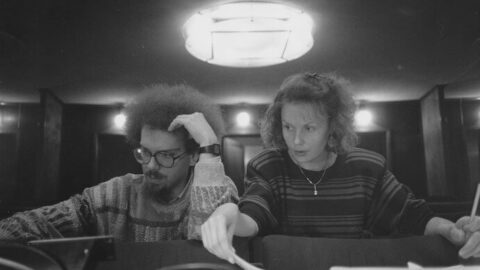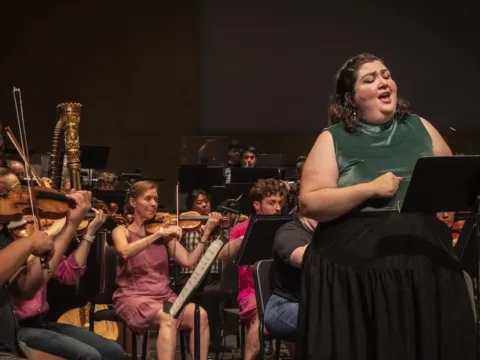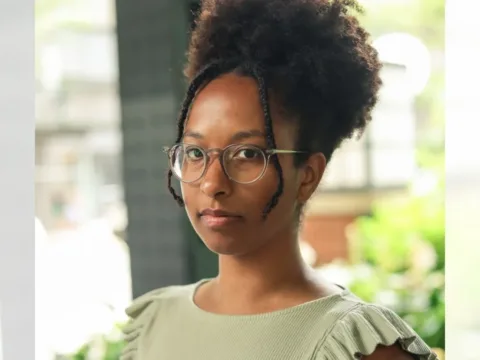Billed by Soundstreams as an “intimate concert plus a discussion,” this was a rare opportunity to watch two renowned contemporary composers at work in a formal yet relaxed setting. Jean-Baptiste Barrière and Kaija Saariaho were in Toronto as guest composers of Soundstreams’ Emerging Composer Workshop; the six young composers taking part in the workshop were present and were introduced to an audience of about 70. Saariaho’s work was featured as well in three evenings of the 21C Music Festival at the Royal Conservatory of Music, which began on May 20, the day after this concert.
The event was held in the 147-seat Théâtre de l’Alliance Francaise Toronto, a brand new space equipped with a 16 x 9 foot screen, 10K video and an immersive audio system. Not only was the setting an intimate one, but the up-to-date specifications meant Barrière’s and Saariaho’s work was presented in an excellent technical environment. The mixing desk was occupied by the duo only, surrounded by several laptops and a digital video camera.
The mid-career composers each had a pair of medium-length pieces on the program, all for live soloist with interactive electronics and/or prerecorded sound accompanied by interactive video. One restart was required, however, the sound was flawless and the crisp video full of warm tones. The soloists interacted comfortably with technology onstage, as much a part of contemporary classical performance practice as extended playing techniques.

Saariaho’s NoaNoa (1992) is for flute with electronic processing of the live sound. Soloist Leslie Newman, equipped with a headset mic and foot controller, handled the score with apparent ease and effortlessly blended multiphonics and vocalizing into the flow of conventionally pitched, non-tonal material. There were echoes of Berio in some places and spectralism in others. The video panned across a primitive woodcut (or primitivist, given the title references Gauguin), with a sudden wash of blood-red hues as the flute sound transformed into piano-like high clusters.
Lonh (1996) was a highlight of the evening. Written for soprano and an electronic part realized at IRCAM, it is based on the medieval poetry of Jaufré Rudel on the theme of love from afar, making it a pre-echo of the composer’s widely performed opera L’Amour de loin (2000). Carla Huhtanen found ardor in abstract material—most notably in the minor mode passages and soaring notes in the latter half of the piece. Her unamplified voice was scaffolded but not dominated by its amplified counterpart in the prerecorded audio, which featured a vocoder effect at points. This and other voices appeared in the audio speaking or singing the text in Occitan, French and English, along with the processed sound of birds. There was a cyborg-like quality to these overall. The accompaniment of electronic gamelan-like percussion sounded of its time in some ways, but avoided a tendency towards exoticism and created an interesting color where it was in unison with the voice. I found myself sensitive to the artificial sound trails, especially at the end. The video suggested an apocalyptic dream with a mix of medieval artwork, fire and water processing and rich washes of color. I would have appreciated accompanying text indicating the sources of the artworks, although their context was clear.

Barrière’s Crossing the Blind Forest (2011) opened the second half of the concert, and Newman appeared with bass flute and later piccolo. There were compelling passages—in particular ghostly breath sounds from the former and a rapid ascent through the range of the latter—but again a reliance on clouds of delay and reverb. The inclusion of the live performers in the videos seemed at times superfluous and often the processing made them appear strangely macabre. The feed from a lighted stage felt at odds with the forest setting and dark mood of the prerecorded video. One of the most memorable images, however, was of the flutist being transformed into an abstract figure of light on screen.
Violance (2003) is a micro drama for violin and narration featuring an excerpt of Maurice Maeterlinck’s 1886 short story “Le Massacre des Innocents.” While Barrière’s and Saariaho’s then young daughter has a singing cameo, the brutal, gruesome tale is read by a woman whose voice was pitched up to sound like a child’s. The effect was convincing and unnerving. The video remains abstract and non-narrative, opening with a starkly beautiful, black and white scene of bare trees in snow. Iridescent colors appear toward the ending, providing some visual relief before the final image: a red seagull against a white sky. Stephen Sitarski moved smoothly through the tastefully appointed violin part, inevitably more an accompaniment than the main focus. Icy glissandi were a perfect pairing with the aforementioned stark trees. There was some noise-based material and “shredding” followed by quasi-tonal, lyrical passages; Barrière does not overstate the contrast between the two. Finally, there is a brief quote of the child’s song, which feels needed after the senseless tragedy we’ve just taken in. This last piece raised an interesting question. As a local conductor-performer put it after the concert: “We got trapped in the subtitles—should we watch the performer or not?”
The concert felt like a master class beyond academy walls; if the audience had been from beyond industry and academic circles. For that matter, diversity was nonexistent, which never ceases to disappoint me in a city as multiracial as Toronto. How can contemporary classical music events become more inclusive? Whatever the backgrounds of those in attendance, their attentiveness and appreciativeness were much in evidence. We all knew we were in the midst of big-deal composers in a low-hype context. Barrière and Saariaho were accessible outside of the performance, something that wouldn’t have been the case in a large institutional venue. They were gracious and down to earth, mingling and engaging in numerous brief exchanges at the post-concert reception.
























